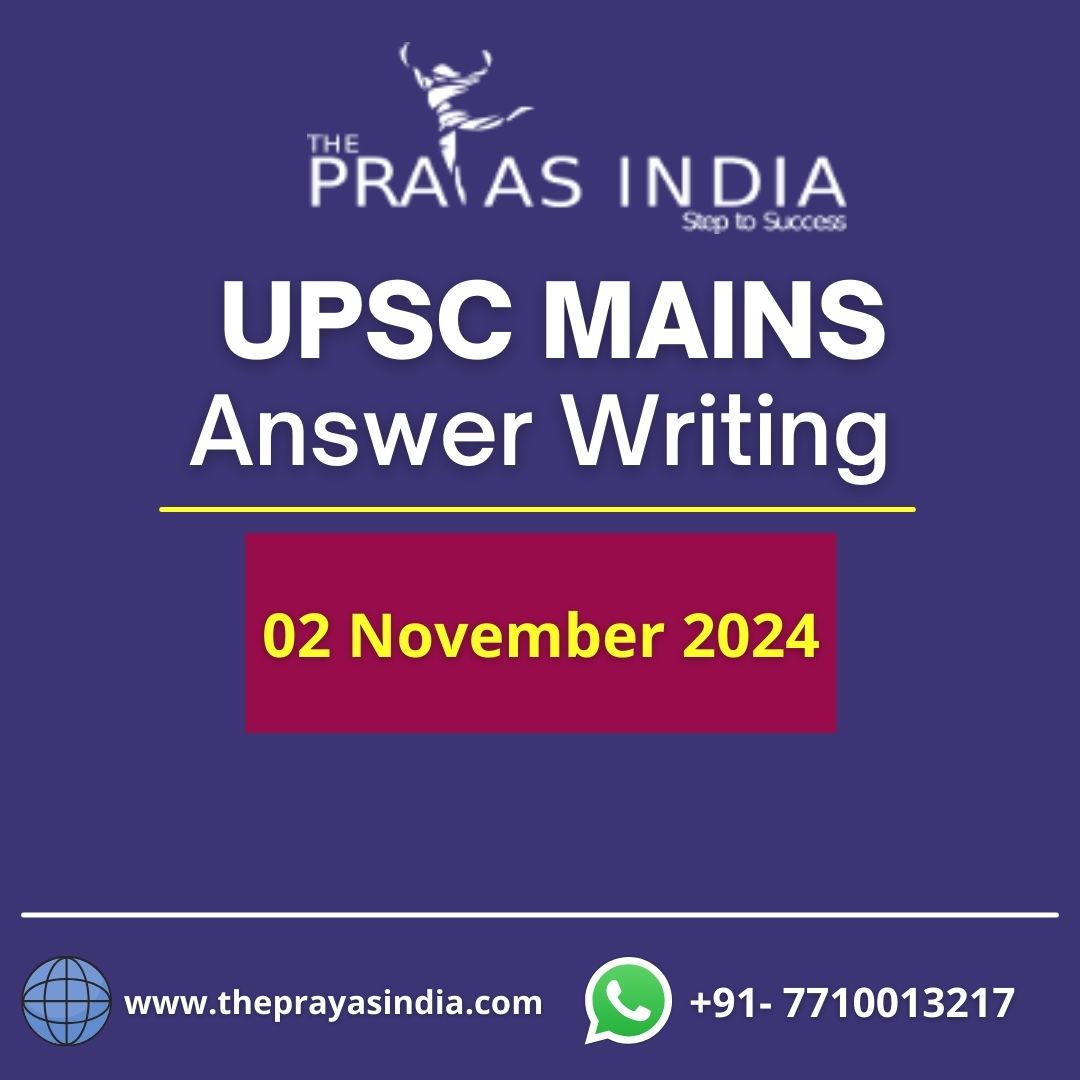MAINS DAILY QUESTIONS & MODEL ANSWERS
Q1. The 30×30 programme has the potential to be extremely important in safeguarding the planet’s biodiversity and ecosystems for coming generations. Analyze.
GS I – Government Policies and Interventions
Introduction:
- By 2030, the 30×30 objective calls for the protection of at least 30% of the world’s land and ocean. The global goal known as the 30×30 target is to stop the rapid extinction of species and save essential ecosystems, which are the foundation of our financial stability.
- In 2021, the High Ambition Coalition (HAC) for Nature and People was established with the goal of securing a global agreement on the 30×30 target. In 2021, India formally became a member of the High Ambition Coalition for Nature and People. To address the requirements and goals of the Pacific Island Countries (PIC), India has proposed to build the Sustainable Coastal and Ocean Research Institute (SCORI).
By encouraging carbon storage in soil and plants, protecting forests and grasslands can aid in slowing down climate change:
- Carbon is naturally absorbed and stored by forests, marshes, grasslands, and other ecosystems.
- According to studies, conserving and maintaining these aspects of nature may enable the annual absorption of one-fifth of all greenhouse gas emissions from the United States, or the emissions from all American cars.
- These environments, which are characterised by tall grasses and prairie plants, are well known for their capacity to take in and hold carbon in the soil and roots.
- Because grasslands encourage biodiversity, support pollinators, and are home to predators that can help suppress potential pests, maintaining them close to agricultural fields can increase crop productivity. They also contribute to better soil health, water quality, and biodiversity.
- In addition to helping to preserve biodiversity, forests may absorb significant amounts of carbon from the atmosphere, slowing down the effects of climate change.
- In addition, decreasing albedo—a measurement of the amount of solar radiation reflected off the earth’s surface—along with changing hydrological cycles (which lower stream flow) and resulting in a loss of rare species are all caused by forest cover.
Possibility of the 30×30 initiative:
- A rising body of scientific evidence suggests that maintaining half of the earth in its natural form is necessary to address the crises of both biodiversity and climate change. Certain articles have proposed a slightly lower figure, while others have suggested an even greater one.
- Nevertheless, scientists concur that reaching a minimum of 30% protection by 2030 is an essential and scientifically plausible interim objective.
- The 30×30 target is justified both globally and regionally, as there is a wealth of scientific data supporting the necessity for higher spatial targets to help fulfil goals connected to biodiversity protection.
- Only about 13% of the world’s land surface was protected when the Aichi Targets were set in 2010, whilst the ocean had relatively few safeguards.
- At the moment, 7% of the ocean and 15% of the land on Earth are thought to be protected. We will need to more than double existing ocean safeguards and double current land protections if we are to meet the target of safeguarding at least 30% by 2030.
The next step:
- First, protected places should serve human needs as well as conservation needs.
- Second, managers and academics should think about how newly established protected areas will interact with nearby areas while designing them.
- Third, scientists and policymakers need to evaluate the ways in which recently established protected zones will interact with distant regions, even foreign nations.
- A metacoupling framework, which is an integrated approach to studying and managing human-nature interactions inside and between diverse areas, need to serve as our guide.
- It acknowledges that both local and distant individuals, governments, and markets have the potential to positively or negatively impact human and environmental systems in a specific location.
Q2. An important turning point in the Indian independence struggle was the Vaikom Satyagraha, which brought attention to the inequities of the caste system and the necessity of social reform. Discuss.
GS I – Modern Indian History
Introduction:
- The first coordinated campaign against orthodoxy in Kerala was the Vaikom Satyagraha, which began in 1924. It was India’s first formal campaign against the practise of untouchability. The goal of the Satyagraha was to guarantee that everyone in society may travel freely across the public roadways that led to the Sri Mahadevar Temple in Vaikom. The great injustice meted out to Dalits was the source of agitation.
About the Vaikom Satyagraha:
- It plays a significant role in Kerala’s Renaissance Movement.
- It was started in 1923 at the Kakinada Congress convention when TK Madhavan gave a report on the discrimination and hardships faced by backward Hindus in Kerala.
- It was determined at the meeting to support movements that oppose untouchability.
Value of the Vaikom Satyagraha:
- During the liberation fight, it symbolised a national movement for justice and equality and cleared the way for the Travancore government’s Temple Entry Proclamation.
Gandhi’s engagement with Congress:
- Vaikom’s problem required handling at a higher and more comprehensive level. Panikkar proposed turning the struggle for road access into a symbolic war against caste-related crimes, giving it a national and international appearance to attract attention from all around the world, rather than merely a fight for access.
- Gandhi and the Congress decided to fully back the Vaikom Movement and to incorporate the abolition of untouchability into their positive programmes.
Broad acceptance:
- India’s press ran headlines on the Satyagraha nonstop. Money poured into Vaikom from many states.
- In order to provide the Satyagrahis with a free kitchen, the Punjabi Akalis travelled to Vaikom.
- Non-Hindus stood up and made Satyagraha offerings. However, Gandhiji rejected all of these.
- This was the first time that a large-scale organised movement for the civil rights of Kerala’s backward castes, including the untouchables, had been carried out.
- The goal of the Vaikom Satyagraha was to rid Hindu society of its impurities, something that Narayana Guru likewise strove to do via his deeds and teachings. It was not an agitation for political freedom.
Vaikom Satyagraha’s effects:
- Satyagraha, Gandhi’s nonviolent weapon, originated with movements like Vaikom.
- Gandhian tenets of satyagraha were put to the test in Vaikom Satyagraha. For the first time, it was tested and shown to be the most successful method.
- During the fight for independence, it turned into a significant occasion in the civil rights movements.
- People from different religious communities, castes, and provinces participated in it, giving it a cosmopolitan feel.
- It signalled the widespread involvement of women in civic engagement. The conflict aided in defining Kerala’s subsequent social identity.
- All Hindus were allowed entry to the temple in 1925, with the exception of the eastern gate.
- Backward castes were granted the freedom to stroll on public roads that led to all of Travancore’s temples by another royal decree in 1928.
- This movement marked a turning point in the history of the lower classes’ emancipation, particularly in Kerala.
- It gave the masses a sense of reason.
- Undoubtedly, the Vaikom agitation has also contributed to communal harmony. Christians, Muslims, and even Sikhs joined forces with progressive Savarnas and Avarnas. It is important to keep in mind that many Savarnas were active leaders up until the Satyagraha’s departure, proving the fundamental unity of the populace.
- The Untouchables, or Harijans, had access to the streets surrounding the shrine. They were given permission to enter the shrine in 1936. The Temple Entry Act that followed was made possible by the Satyagraha.
Way Forward:
- This was the first time in Kerala’s history that a large-scale organised movement for the fundamental rights of the untouchables and other backward castes was being carried out. Vaikom Satyagraha developed into India’s main human rights movement and a trial ground for significant tactics such as satyagrahas.
- The Kerala government has now made the decision to host a number of cultural events in remembrance of the movement. Vaikom is a representation of social fairness and the dismantling of caste boundaries.




